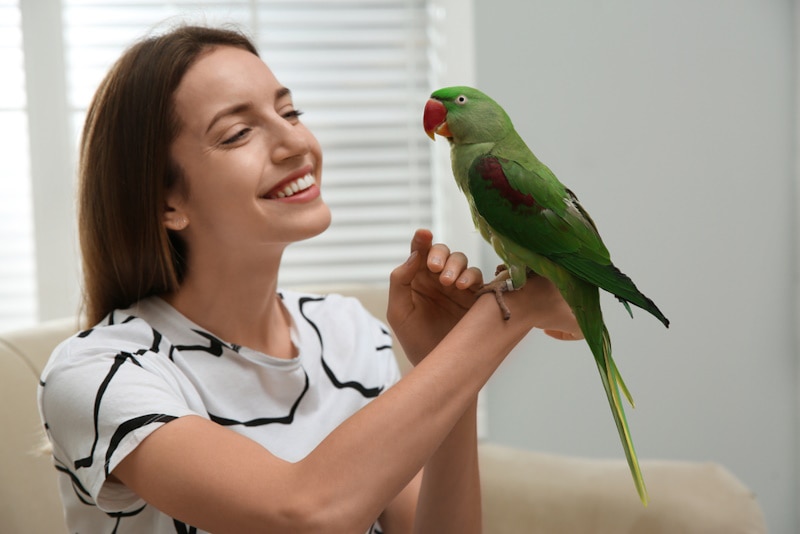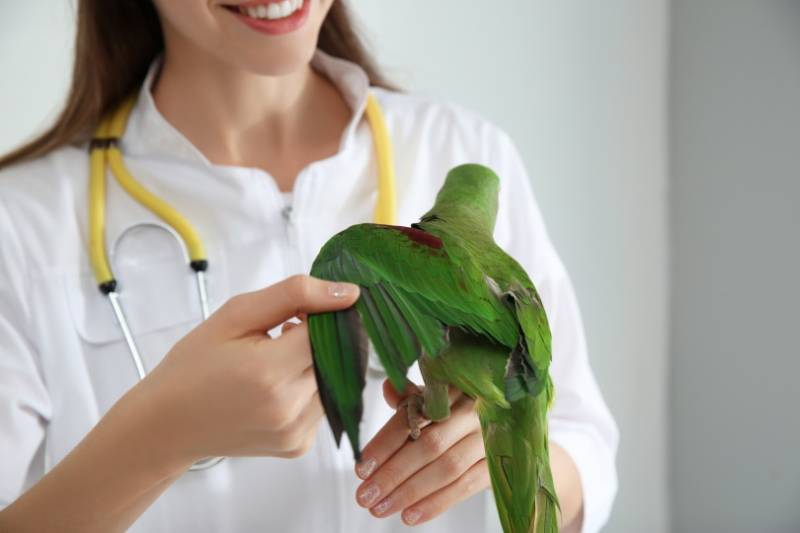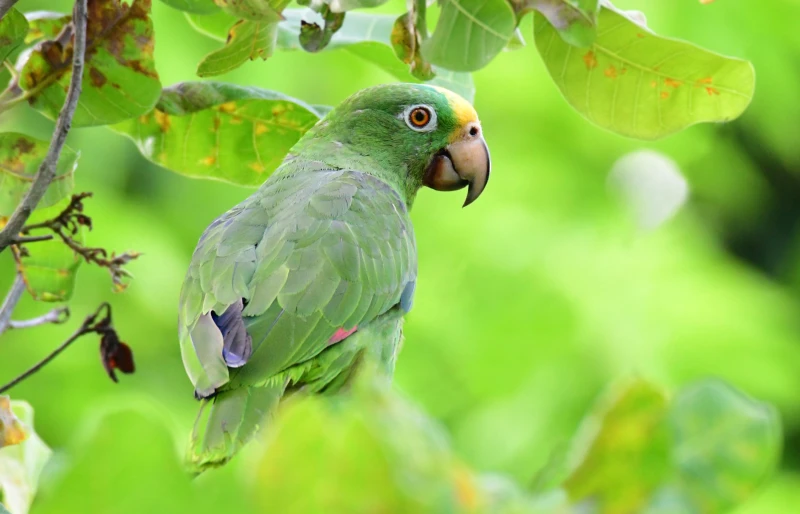How to Trim Parakeet Nails: 9 Vet-Approved Tips & Tricks
Updated on

All pet owners have some not-so-great pet-related responsibilities. Cat parents, for example, have to change their pet’s litter daily. Dog owners need to pick up their dog’s feces. Parakeet keepers need to clip their pet’s nails. While it sounds easy enough, if you’ve ever tried trimming a moody bird’s nails, you know how challenging it can be. Lucky for you, we’re coming in clutch with some helpful tips and tricks to make the process much easier. Because there are so many parakeet species, we are going to focus on the Rose-ringed parakeet (Psittacula krameri) for this article.
Read on to learn how to trim your parakeet’s nails without anybody losing any blood.
Before You Begin
Before you trim your parakeet’s nails, there are some crucial steps and considerations you must take.
Understand Nail Anatomy

You need to be careful when trimming your parakeet’s nails so as not to clip the quick. The quick is a blood vessel and nerve that’s found partway down the middle of every nail. The longer your bird’s nails are, the longer their quick may be. For birds with lighter-colored nails, spotting the blood vessel is easy as it’s the pink area in the middle of the nail. However, the quick will not be visible in birds with dark nails.
If you nick the quick, it can bleed profusely, and stopping the blood flow can be challenging. This is why we recommended having a clotting agent like styptic powder on hand. Due to their small size, a little blood loss in human terms can be a lot for your bird. You want to avoid bleeding and seek experienced help if you make your bird bleed more than once.
Gather Your Supplies
You’ll need several supplies to trim the nails. These include:
- Towel. You’ll use this to hold your parakeet to protect you from bites and keep your pet calm. We recommend using a light-colored towel as brighter colors may be alarming for your bird.
- Nail clippers. We recommend buying a pair made specifically for birds.
- A second set of hands. Having a second person on hand to assist will be very helpful, especially if this is your first time trimming your parakeet’s nails.
- Styptic powder. This antihemorrhagic is great to have on hand in case you cut a little too close to your parakeet’s quick when clipping their nails.
The 9 Tips & Tricks for Trimming a Parakeet’s Nails
1. Familiarize Your Bird With the Towel
The first time your parakeet sees the towel they’ll eventually be wrapped in for nail trimming should not be minutes before you start the task. Set yourself up for success by getting your parakeet accustomed to the towel well in advance. Lay it down on your hand and allow your parakeet to climb up to inspect it. Give them plenty of encouragement, praise, and maybe even a treat or two to help them associate the towel with positive things.

2. Pick the Right Time
Choosing the right time of day to do the trim is critical to your success. Don’t pick a time when you know your bird is likely to be grumpy or overexcited, like right before dinner.
3. Drape the Towel Over the Back
The first step in trimming your parakeet’s nails is draping the towel over their back. Keep the wings tucked in at the sides so as not to injure your pet. Do not squeeze them as birds cannot breathe unless their chest can move. Birds don’t have diaphragms, and too much pressure on their chests can cause suffocation.
4. Keep Yourself Safe
Know that your bird is not going to be particularly fond of being draped in the towel, so take control of their head to prevent bites. Hold their body with one hand and use the other to hold their head gently. Put your thumb on one side and the index finger on the other to prevent them from moving their head freely. Smaller species of parakeet can be restrained in one hand with the body in the palm of the hand and head between the index and middle fingers. Use plenty of kind, affirming words in a quiet voice to try to keep them calm.

5. Know How to Hold the Foot
Holding your parakeet’s foot in just the right way will make the nail-clipping process much easier and quicker. Put a finger near your bird so they can grasp onto it. Once they’re holding onto you, use your thumb to lift the nails off of your finger so you can get the clippers in to get the job done.
6. Clip Just a Smidge
It’s better to clip too little off of the nail and have to go back a second time to take off more than to clip too much the first time and hurt your parakeet.
7. Know What to Do if You Cut the Quick
Even the most careful nail trimmers can accidentally cut into their parakeet’s quick. Blood loss is very dangerous in birds, so if you do cut the vein, quickly apply styptic powder to stop the bleeding. You may also wish to consult with your avian vet if you feel your parakeet has lost too much blood. If you don’t have styptic powder, cornstarch can work in a pinch.

8. Remove the Styptic Powder
If you wind up using the styptic powder to stop blood loss, take time to remove the powder after the bleeding has stopped. Parakeets preen their feet and inevitably ingest any substances from their nails, including the leftover powder.
9. Know When to Call the Pros
If you’re not confident in your nail trimming abilities, know it is perfectly acceptable to contact the professionals for help. Your avian vet is well-versed in nail clipping, so they can certainly do it for you if you need assistance or don’t feel up to the task. It’s also not a bad idea to call pet stores in your area to see if they offer this service.

How Do I Know If My Parakeet’s Nails Need Trimming?
Nail trims can be stressful for you and your bird, so it’s best not to do them unnecessarily. Thankfully, there are several pretty obvious signs that your parakeet is overdue for a trim, so you won’t have to put them (and you) through the rigamarole unless it’s necessary.
- Their nails look and feel long
- Their perching behavior changes (e.g., favoring one foot over another)
- They’re having problems getting around (e.g., nails are getting caught in your clothing)
- Their skin is patchy or rough from being scratched by their nails
- You’re getting scratched
Final Thoughts
Trimming a parakeet’s nails can be stressful for both you and your bird, but with our helpful tips, you should be able to get the job done in no time flat. If you’re feeling anxious about the task at hand, though, don’t be embarrassed to call in the experts for help. Avian vets and groomers know their way around small animal nails and can do it for you, no questions asked.
See also:
Featured Image Credit: New Africa, Shutterstock













